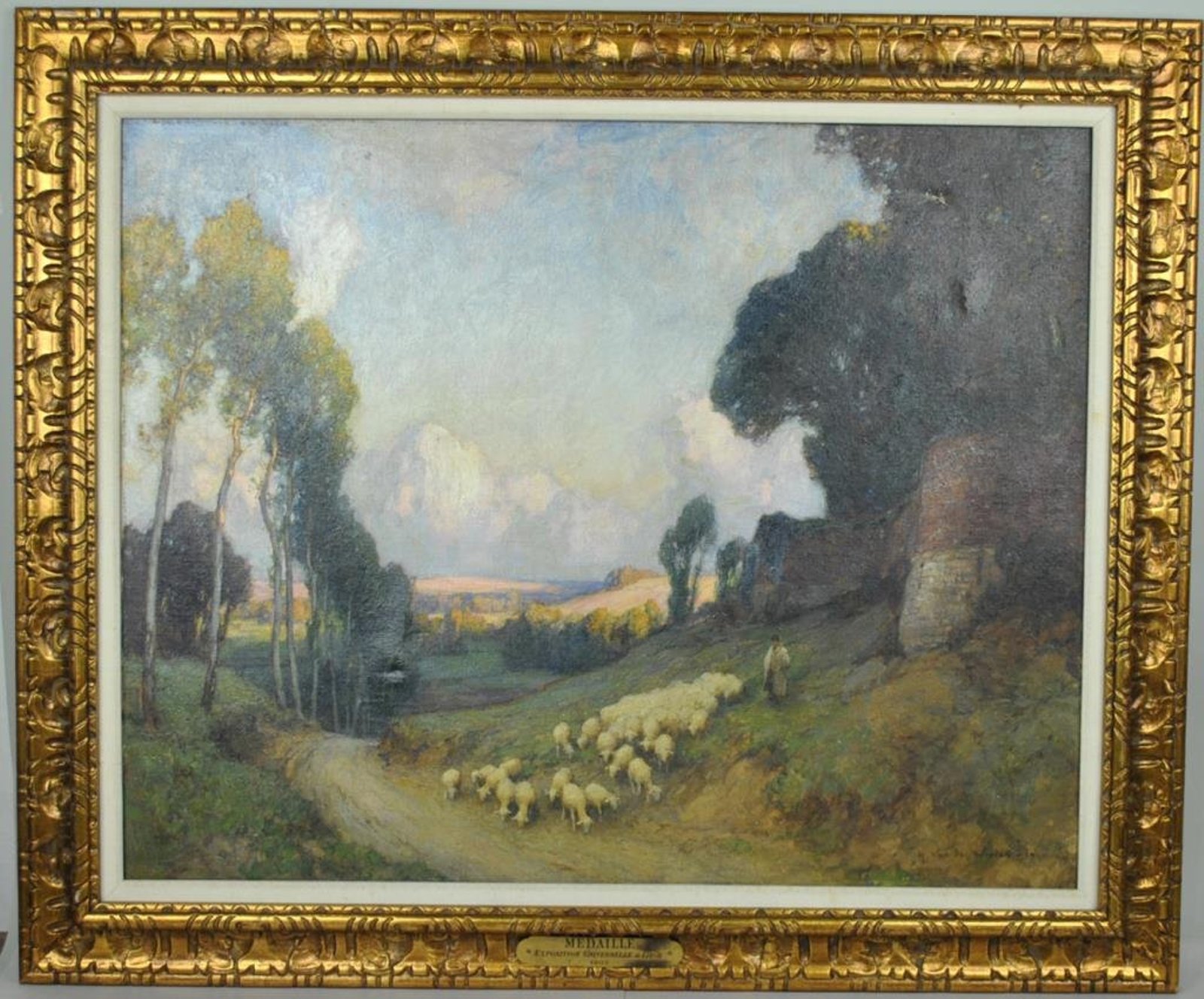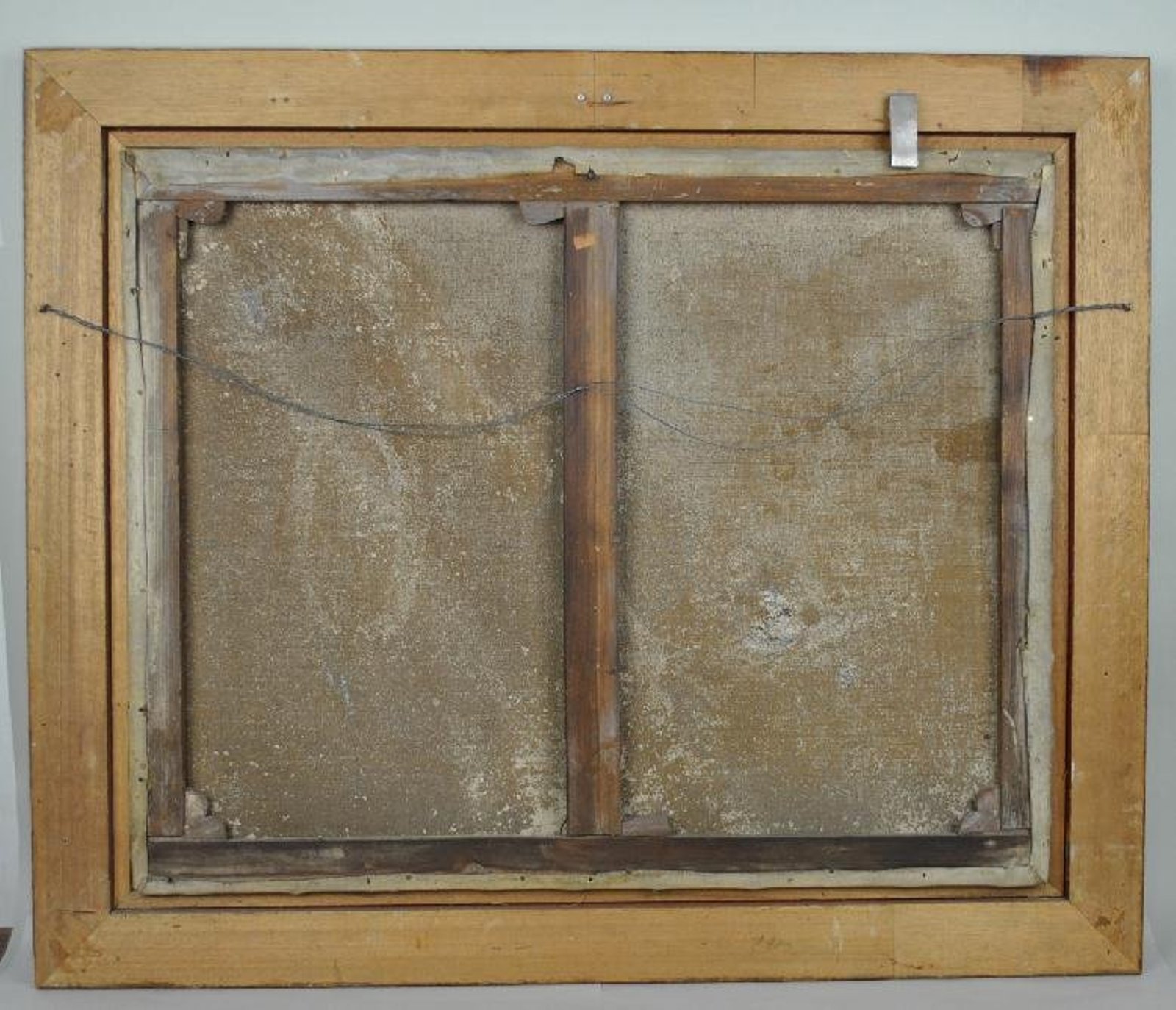 Image 1 of 4
Image 1 of 4

 Image 2 of 4
Image 2 of 4

 Image 3 of 4
Image 3 of 4

 Image 4 of 4
Image 4 of 4





SOLD - Harry van der Weyden
Harry van der Weyden (American, 1868-1952)
“Landscape with herder and sheep”
Oil on Canvas
Signed on verso: 'H. Van der Weyden - 1905', lower right. Placard annotated 'Medaille / Exposition Universelle de Liege / 1905
Frame: 29 x 37 inches
Largely associated with the turn-of-the-century artistic life of Paris and London, Harry Van der Weyden, although born in Boston (8 September 1868), was not a product of the Boston School. Instead, he won a scholarship to study in the Slade School in London when he was nineteen. Perhaps the painter was distantly related to the Flemish Old Master Rogier van der Weyden.
At any rate, he spent the 1890-91 school year at the Académie Julian in Paris under Jean-Paul Laurens, Benjamin Constant, and Jules-Joseph Lefebvre. Then at the 1891 Salon he exhibited two landscapes. That year he was also at Etaples. Recent research on the painter by Jean-Claude Lesage (2007) reveals that Van der Weyden associated with Max Bohm and Irving Couse. Van der Weyden established a residence at Montreuil-sur-Mer, fifteen kilometers from Etaples, a short drive in his fancy Phaeton convertible. While at Montreuil, his family grew, and he was an important member of the artists colony there. Lesage regards Van der Weyden as one of the most distinguished artists at Montreuil, "and among American painters in Pas-de-Calais, the one who practiced impressionist painting in a most affirming manner."
Van der Weyden exhibited regularly in Paris in both Salons, as well as at the Art Institute of Chicago (1896-1913), and the Pennsylvania Academy of the Fine Arts (1901-09). At the World's Columbian Exposition, he exhibited a Dutch subject, Katwijk Herring Boats and in 1900, won a bronze medal at the Paris Universal Exposition for Calm and The Hillside (all unlocated). The Shepherd, illustrated in the catalogue of the Anglo-American Exposition in 1914, acknowledges impressionism with its plein-air feeling, strong lighting effects, the "accidental" composition, and the high horizon line.
During World War I, the artist worked with the Royal Engineers as a camouflage officer (1916-18). Some of his landscapes are essentially tonalist, recalling Birge Harrison's paintings. Most of Van der Weyden's paintings are in private collections but the Museum of Montreuil-sur-Mer has The End of the Day, Shepherd, and Little River at Neuville-sous-Montreuil. Portrait of a Young Boy is in the Blérancourt Museum.
Van der Weyden died in London in 1952.
Various Sources.
Harry van der Weyden (American, 1868-1952)
“Landscape with herder and sheep”
Oil on Canvas
Signed on verso: 'H. Van der Weyden - 1905', lower right. Placard annotated 'Medaille / Exposition Universelle de Liege / 1905
Frame: 29 x 37 inches
Largely associated with the turn-of-the-century artistic life of Paris and London, Harry Van der Weyden, although born in Boston (8 September 1868), was not a product of the Boston School. Instead, he won a scholarship to study in the Slade School in London when he was nineteen. Perhaps the painter was distantly related to the Flemish Old Master Rogier van der Weyden.
At any rate, he spent the 1890-91 school year at the Académie Julian in Paris under Jean-Paul Laurens, Benjamin Constant, and Jules-Joseph Lefebvre. Then at the 1891 Salon he exhibited two landscapes. That year he was also at Etaples. Recent research on the painter by Jean-Claude Lesage (2007) reveals that Van der Weyden associated with Max Bohm and Irving Couse. Van der Weyden established a residence at Montreuil-sur-Mer, fifteen kilometers from Etaples, a short drive in his fancy Phaeton convertible. While at Montreuil, his family grew, and he was an important member of the artists colony there. Lesage regards Van der Weyden as one of the most distinguished artists at Montreuil, "and among American painters in Pas-de-Calais, the one who practiced impressionist painting in a most affirming manner."
Van der Weyden exhibited regularly in Paris in both Salons, as well as at the Art Institute of Chicago (1896-1913), and the Pennsylvania Academy of the Fine Arts (1901-09). At the World's Columbian Exposition, he exhibited a Dutch subject, Katwijk Herring Boats and in 1900, won a bronze medal at the Paris Universal Exposition for Calm and The Hillside (all unlocated). The Shepherd, illustrated in the catalogue of the Anglo-American Exposition in 1914, acknowledges impressionism with its plein-air feeling, strong lighting effects, the "accidental" composition, and the high horizon line.
During World War I, the artist worked with the Royal Engineers as a camouflage officer (1916-18). Some of his landscapes are essentially tonalist, recalling Birge Harrison's paintings. Most of Van der Weyden's paintings are in private collections but the Museum of Montreuil-sur-Mer has The End of the Day, Shepherd, and Little River at Neuville-sous-Montreuil. Portrait of a Young Boy is in the Blérancourt Museum.
Van der Weyden died in London in 1952.
Various Sources.
Condition: UV light shows a few small areas of inpainting, slight canvas bulge and 1" tear repair to upper right quadrant, 1.5x1" tear repair to lower left center, crazing
